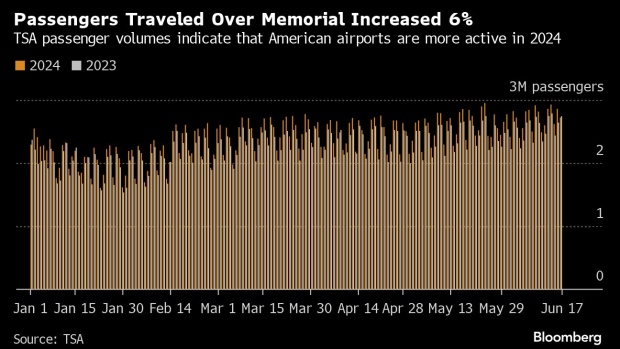(Bloomberg) — A record high of about 71 million Americans are expected to travel over the Independence Day holiday early next month, giving hope to oil bulls who are banking on stronger demand during the crucial summer driving season.
According to the American Automobile Association, about 60.6 million Americans are expected to drive more than 50 miles (80 km) from home between June 29 and July 7, up 4.8% from last year. About 5.74 million people are expected to fly during the same period, up 6.9%, while an additional 4.62 million people are expected to travel by other means.
The expected travel boom will be an encouraging signal for oil traders who are betting that rising fuel demand will tighten U.S. crude oil markets this summer. Higher U.S. oil consumption will also help offset concerns about weaker consumption elsewhere, especially China.
In the U.S., travel growth remains strong even as wage growth slows and pandemic savings fade, with road trips once considered revenge spending now becoming the norm, according to AAA. Further spurring road trips is retail gasoline prices that are below seasonal levels from the past two years.
“People may be cutting back on material purchases, but they're not cutting back on experiences,” said AAA spokeswoman Aisha Diaz.
The recovery in air travel in particular has been a bright spot for fuel demand, with one measure of jet fuel consumption at its highest level since 2019. The number of passengers flying over the Memorial Day holiday in May was about 6% higher than in 2023, according to JPMorgan Chase analysts citing data from the Transportation Security Administration.
In contrast, gasoline demand is expected to soften as improved fuel efficiency in vehicles curbs consumption growth even as Americans are driving more miles. Spending at gas stations was flat year-over-year during the May holiday period, according to RBC Capital Markets.
Demand for gasoline has been weak so far this summer, with peak consumption about 10 percent lower than last year, said Patrick de Haan, head of petroleum analysis at GasBuddy.
“Peak demand for gasoline is usually in late July, so there's still some opportunity,” he said, “but it looks like it's at a slightly lower level than last year.”
–With assistance from Julia Fanzeres and Augusta Saraiva.
©2024 Bloomberg LP



